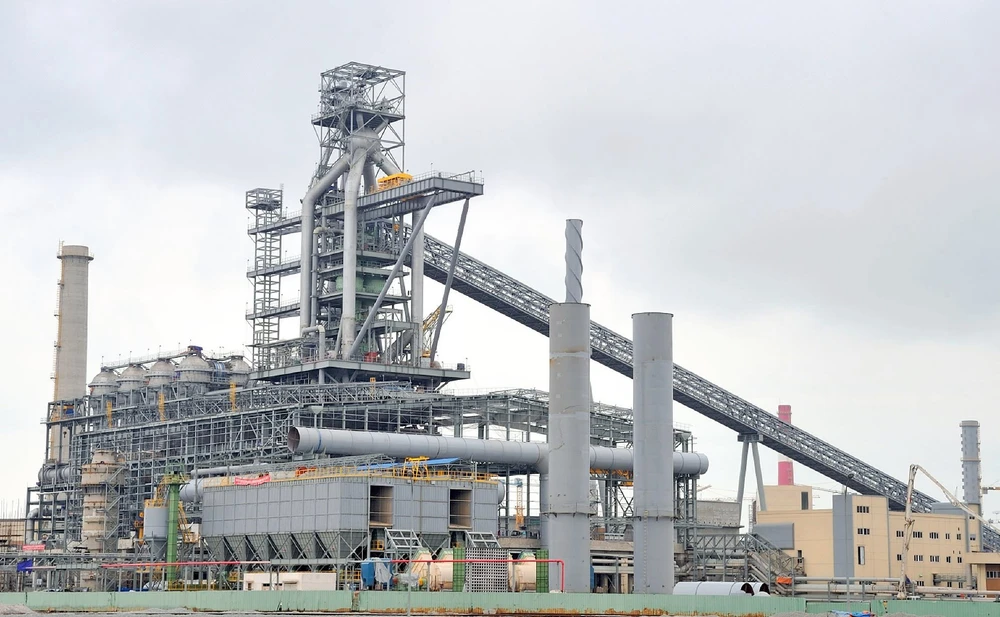
Formosa Ha Tinh Steel, or FHS, said the trade fracas could push more inexpensive Chinese-made steel products into Vietnam, Southeast Asia's biggest steel consumer, and cause prices to tumble.
Overall, Vietnam is seen as a beneficiary of the trade war, but FHS's dilemma shows that the country's industries could suffer.
Formosa Plastics, a Taiwanese plastics manufacturer, owns more than 70% of FHS, with Taiwan's China Steel holding 20% and Japan's JFE Steel 4%. FHS operates Vietnam's only integrated blast furnaces, in the central Vietnamese province of Ha Tinh.
The first blast furnace went into use in 2017. The second followed a year later.
The Ha Tinh plant is now capable of producing 7.1 million tons of crude steel per year.
With a goal of becoming Southeast Asia's largest integrated steelmaker, a distinction currently held by Krakatau Posco in Indonesia, FHS had planned to start building another blast furnace in or after 2020 to boost its capacity to more 10 million tons near term and to 22.5 million tons in the long term.

"We will carefully examine the plan as uncertainties are growing over the outlook of the U.S.-China trade war," FHS Chairman Chen Yuan-cheng said in an interview with Nikkei. FHS will decide when to begin building the blast furnace by the end of the year through talks with its three shareholders and the Vietnamese government, he added.
FHS, which had been steadily expanding production, is now assuming a cautious business stance due to the trade war uncertainties.
In China, steel prices are on the wane as an economic slowdown weakens demand. As a result, concerns are emerging that the global steel industry will again find itself with excess capacity and lapse back into decline, a fate it escaped several years ago.
Vietnam imports more than 8 million tons of hot-rolled coil per year, 40% of which comes from China. With no import tariffs on the product, inexpensive Chinese coil keeps arriving.
Hot-rolled coil in Vietnam is currently quoted at $500 per ton, down 10% from a year ago, according to FHS. Prices will drop further if imports from China increase. For FHS, this would result in a drop in earnings, even if it were to increase sales.
"Competition with imports is intensifying," Chen said.
FHS is thought to be planning to construct two blast furnaces equivalent to its existing furnaces in terms of capacity. The total cost, including related expenses, could climb to $4 billion. Once a blast furnace starts operating, it cannot be readily halted. Therefore, FHS intends to carefully gauge how much longer the U.S.-China trade war will last.
As Vietnam's economy has grown, so too has its demand for construction materials, making the country Southeast Asia's largest consumer of steel. Vietnam in 2016 surpassed Thailand in apparent steel use, which represents the consumption of finished steel products in a country. In 2018, it went through 22.3 million tons of steel, up 3% from the previous year.
On a per capita basis, Vietnam consumes some 240 kg of steel a year, four times more than Indonesia. With reinforced-concrete houses popular in Vietnam, "solid homes using lots of iron are preferred, compared with neighboring countries," an official of a Japanese trading house said.
Vietnam's economy continues to grow at a faster pace than those of neighboring countries, with gross domestic product maintaining an annual pace of 6% to 7%. Investment in urban railways and other pieces of infrastructure is up sharply. And foreign companies keep opening manufacturing bases in the country, resulting in more steel being consumed.

The supply of steel products for automobile production is also expected to grow. Vingroup on Monday began selling cars designed and made in Vietnam. The big conglomerate, which has yet to set up a full-scale auto-making plant, initially intends to produce 250,000 vehicles per year. It hopes to raise that figure to 500,000 in the future, but then it would likely need a factory to produce high-quality steel sheet.
In expectations of the country's demand for steel to increase, Hoa Phat Group, a leading Vietnamese steelmaker, will begin operating a blast furnace with an annual capacity of 1 million tons in the central province of Quang Ngai, possibly later in June. Hoa Phat plans to increase capacity to 4 million tons next year.
When FHS's planned capacity increases are completed, the two companies combined will be able to produce around 26.5 million tons, equivalent to nearly 30% of Japan's crude steel capacity (Japan has the world's third largest crude steel capacity).
Early this century, the global steel industry was shaken by plummeting prices, the result of China dumping steel on the market. China would eventually account for 50% of global steel production.
Although China has reduced its steel capacity, it is again looking to overseas markets to soak up products as domestic demand wanes in reaction to the U.S.-China trade war.
Inexpensive shipments from China are destabilizing global markets once again.




















